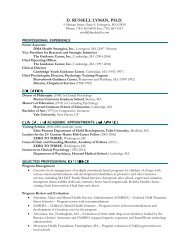Commonwealth of Massachusetts - DMA Health Strategies
Commonwealth of Massachusetts - DMA Health Strategies
Commonwealth of Massachusetts - DMA Health Strategies
- No tags were found...
You also want an ePaper? Increase the reach of your titles
YUMPU automatically turns print PDFs into web optimized ePapers that Google loves.
FOCUS AREA VIII:STRENGTHEN COLLABORATIONS AND INCREASE THE INTEGRATION OFSUBSTANCE USE AND ADDICTIONS SERVICES WITHIN THE CRIMINALJUSTICE SYSTEMRATIONALE: Substance use and addictions continues to have a significant impact on the criminal justice andcorrections systems. For example, the Probation Commissioner’s <strong>of</strong>fice has data indicating that 85 percent <strong>of</strong>their population is addicted, or a substance precipitated their crime, and 45 percent need treatment.Furthermore, in 2009, 50 percent <strong>of</strong> the individuals admitted into BSAS supported residential programs wereon Probation (45.6 percent) or Parole (5.0 percent) and 39 percent <strong>of</strong> all those admitted to ambulatoryprograms were on Probation. Seven percent (614) <strong>of</strong> residential admissions entered directly from incarceratedstatus at Houses <strong>of</strong> Correction (HoC) or Department <strong>of</strong> Correction (DoC) facilities. In FY 09 BSASexpanded its treatment system by 104 beds to serve civilly committed individuals who had previously gone toMCI-Bridgewater (MASAC). Because data indicated that a large number <strong>of</strong> overdoses were experienced byindividuals who had recently been released from correctional institutions, BSAS began to provide training onoverdose prevention to all the HoCs, DoC, and civil commitment programs. Since 2005, considerableprogress has been made toward assuring that treatment is available within HoCs and that individuals leavingHoCs are helped to enroll in Medicaid and to receive prescriptions and/or medications. In FY 09,approximately 1,550 parolees received case management services through a program funded collaborativelyby BSAS and the Parole Board. There is room for improvement, however, in all <strong>of</strong> these areas. Several HoCshave done small studies <strong>of</strong> their populations; for example, Plymouth County found that recidivism wassignificantly higher (34 percent) for those who did not receive treatment while incarcerated than for thosewho did (18 percent).Strategy 1: Expand planning and coordination <strong>of</strong> drug courts.Implementation Team Leader: Criminal Justice Service Coordinator, BSAS• Identify a statewide drug court coordinator.• Bring together representatives <strong>of</strong> all currently functioning adult and youth drug courts for regularmeetings.• Use meetings to share information on sources <strong>of</strong> funding, on best practices and on how to encouragedevelopment <strong>of</strong> additional drug courts throughout the <strong>Commonwealth</strong>.Strategy 2: Support correctional facilities in adopting medication assisted treatment.Implementation Team Leader: Deputy Director, BSAS• Develop informational materials to be shared with the correctional system.• Encourage small pilot efforts to introduce medication assisted treatment in a few settings.• Encourage further development <strong>of</strong> medication assisted treatment programs based on the results <strong>of</strong>the pilot efforts.Substance Abuse Strategic Plan Update Page 22July 2010





